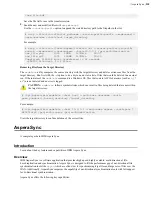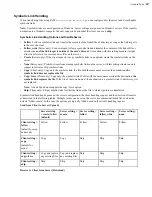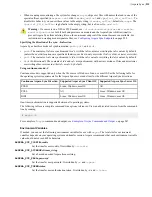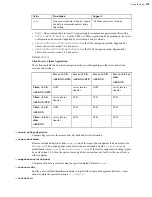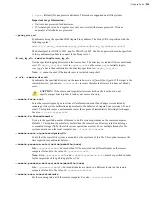
| Aspera Sync |
232
For example, use
-d
to set the local directory to Morgan's
data
folder:
async -L "C:\Users\Morgan\Aspera jobs\log" -N job1 -i c:/users/
morgan/.ssh/id_rsa -b "C:\Users\Morgan\Aspera jobs\db" -l 500m -d c:/
users/morgan/data
9.
Specify the transfer username, remote host, and remote directory for synchronization.
Unlike previous options for which one short option flag was equivalent to one long option flag, when specifying
the username, remote host, and remote directory, the short flag option is the equivalent of one to three long option
flags. For example, if the username is
morgan
, the remote host IP address is
10.0.0.1
, and the remote directory is
/
data
, then the following options are equivalent to each other:
-r [email protected]:/data
[email protected]:/data
--user=morgan --remote-dir=10.0.0.1:/data
--user=morgan --host=10.0.0.1 --remote-dir=/data
If the name of your remote directory contains an "@", use the
--user
option so that the "@" is not treated
specially in the argument for
--remote-dir
.
For example, use
-r
to set the username, remote host, and remote directory:
async -L "C:\Users\Morgan\Aspera jobs\log" -N job1 -i c:/users/
morgan/.ssh/id_rsa -b "C:\Users\Morgan\Aspera jobs\db" -l 500m -d c:/
users/morgan/data -r [email protected]:/data
10.
If a source directory is on an NFS or CIFS mount, require Aspera Sync to use the mount signature file.
Warning:
If you do not use the mount signature file and the NFS or CIFS mount is unreachable, Aspera
Sync considers those files as deleted and deletes them from the other endpoint.
If the local endpoint is on a NFS or CIFS mount and the Aspera Sync is push or bidirectional, use
--local-
mount-signature
. If the remote endpoint is on a NFS or CIFS mount and the Aspera Sync is pull or
bidirectional, use
--remote-mount-signature
.
11.
Specify the locations for the remote Aspera Sync log and database.
On the server, Aspera Sync logs to the default location (see
on page 264) if no location is specified for
<async_log_dir>
in the server's configuration file. Aspera recommends using
-R
(or
--remote-logdir
)
to specify a logging location to which you have access. The location must be within your docroot on the server,
unless you are synchronizing with AWS S3 object storage.
-R
is overridden by the server's configuration file. If
you are restricted to aspshell on the server, you cannot use this option.
Aspera also recommends using
-B
(or
--remote-db-dir
) to specify a location for the remote Aspera Sync
database. As with the log file, the location must be within your docroot, it is overridden by
<async_db_dir>
in
the server's configuration file, and you cannot use this option if you are restricted to aspshell.
As on the local computer, the Aspera Sync log and database must not be in a directory that is being synchronized.
For example, to set the remote log and snapshot database files to Morgan's home folder:
async -L "C:\Users\Morgan\Aspera jobs\log" -N job1 -i c:/users/
morgan/.ssh/id_rsa -b "C:\Users\Morgan\Aspera jobs\db" -l 500m -d c:/
users/morgan/data -r [email protected]:/data -R /morgan/async/log -B /
morgan/async/db
12.
Specify the synchronization mode.
Aspera Sync can be run in three modes:
•
push
: The contents of
ldir
are synchronized to
rdir
, with the
ldir
content overwriting the
rdir
content, by
default (unless the overwrite options are specified otherwise, such as to only overwrite if
rdir
is older, or never
overwrite).

